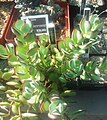
The Crassulaceae, also known as the stonecrop family or the orpine family, are a diverse family of dicotyledon flowering plants characterized by succulent leaves and a form of photosynthesis, known as Crassulacean acid metabolism (CAM). Flowers generally have five floral parts. Crassulaceae are usually herbaceous but there are some subshrubs, and relatively few treelike or aquatic plants. Crassulaceae are a medium-sized monophyletic family in the core eudicots, among the order Saxifragales, whose diversity has made infrafamilial classification very difficult. The family includes approximately 1,400 species and 34–35 genera, depending on the circumscription of the genus Sedum, and distributed over three subfamilies. Members of the Crassulaceae are found worldwide, but mostly in the Northern Hemisphere and southern Africa, typically in dry and/or cold areas where water may be scarce, although a few are aquatic.
Pachypodium bicolor is a species of plant in the family Apocynaceae.

Pachypodium brevicaule is a species of plant that belongs to the family Apocynaceae.
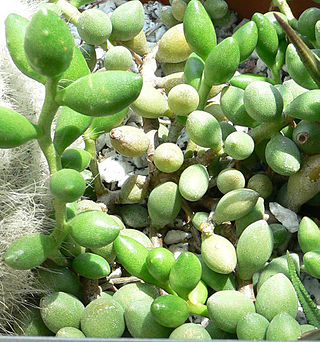
Adromischus is a genus of flowering plants. They are easily-propagated, leaf succulents from the family Crassulaceae, which are endemic to southern Africa. The name comes from the ancient Greek adros (=thick) and mischos (=stem).

Cotyledon orbiculata, commonly known as pig's ear or round-leafed navel-wort, is a South African succulent plant belonging to the genus Cotyledon.

Tylecodon is a genus of succulent plants in the family Crassulaceae, native to southern Africa.
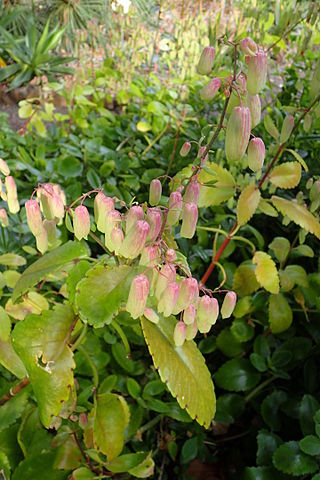
Kalanchoe pinnata, commonly known as cathedral bells, air plant, life plant, miracle leaf, Goethe plant, and love bush, is a succulent plant native to Madagascar. It is a popular houseplant and has become naturalized in tropical and subtropical areas. The species is distinctive for the profusion of miniature plantlets that form on the margins of its leaves, a trait it has in common with some other members of Bryophyllum.

Dudleya farinosa is a species of succulent plant in the family Crassulaceae known by several common names, including bluff lettuce, powdery liveforever, and powdery dudleya. A coastal plant of northern California and southern Oregon, it is typically found on ocean bluffs just directly above the reach of the waves, and sometimes inland. Its appearance is characterized by lotus-like rosettes of beveled leaves, and in summer the plant erects a tall pink to red peduncle densely covered in bracts, topped with branches of pale yellow flowers. The green or white rosettes of this plant can be seen covering stretches of rocky coast and nearby islets.
This glossary of botanical terms is a list of definitions of terms and concepts relevant to botany and plants in general. Terms of plant morphology are included here as well as at the more specific Glossary of plant morphology and Glossary of leaf morphology. For other related terms, see Glossary of phytopathology, Glossary of lichen terms, and List of Latin and Greek words commonly used in systematic names.

Cotyledon tomentosa is a species of flowering plant in the family Crassulaceae, native to South Africa. It is a succulent evergreen shrub with large chunky ovate fuzzy green leaves. Its autonymous subspecies is known as the bear's paw because of the prominent "teeth" at the tips of its leaves. It forms large orange bell-shaped flowers in spring.
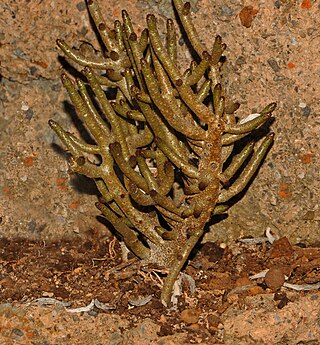
Tylecodon buchholzianus is a species of succulent plant in the genus Tylecodon belonging to the family Crassulaceae.

Adromischus cooperi is a species of succulent plant from the family Crassulaceae. The genus name Adromischus comes from ancient Greek adros and mischos, and the species name from Thomas Cooper. The plant is endemic to the Eastern Cape of South Africa.

Scaevola plumieri is a species of plant in the family Goodeniaceae which grows on coastal dunes in the tropics and subtropics.

Kalanchoe sexangularis, also known as bushveld kalanchoe, six-angled kalanchoe, or red-leaved kalanchoe, is a species of the succulent genus Kalanchoe, in the family Crassulaceae that is native to Southern Africa.

Dudleya linearis is an insular succulent plant known by common name as the San Benitos liveforever. It is a rosette-forming perennial characterized by its long, flat green leaves on clustered heads and its yellow flowers. It is endemic to the western island of the Islas San Benito, a small Mexican archipelago in the Pacific Ocean west of Cedros Island. The limited population of the species is vulnerable, and has twice come close to extinction from introductions of grazing animals.

Dudleya cymosasubsp. cymosa is a subspecies of succulent perennial plant in the family Crassulaceae endemic to California. It is the autonymous subspecies for Dudleya cymosa, and is known by the common name canyon liveforever. It is native to the California Coast Ranges, the Sierra Nevada and the Santa Monica Mountains. It is characterized by bright-yellow, orange or red flowers and broad, wide leaves. This plant is commonly found growing on rocky outcrops, talus slopes, and in shaded canyons.

Tylecodon paniculatus, also known as butter bush, butter tree, butterboom or rooisuikerblom (Afrikaans), is a species of succulent plant in the genus Tylecodon belonging to the family Crassulaceae.

Adromischus alstonii is a species of succulent plant from the family Crassulaceae. The species name is the namesake of Edward Garwood Alston, who was a plant enthusiast from Cape Province, South Africa. A. alstonii is endemic to the Succulent Karoo in the Northern Cape, South Africa.
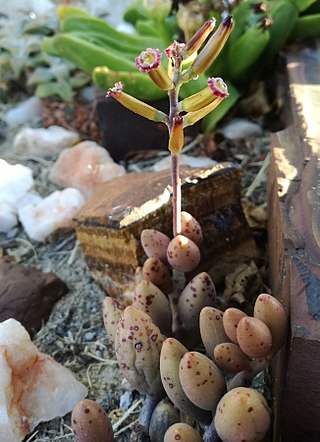
Adromischus filicaulis is a perennial, succulent plant in the family Crassulaceae. It is commonly called brosplakkies in Afrikaans. The species is endemic to South Africa and Namibia.














